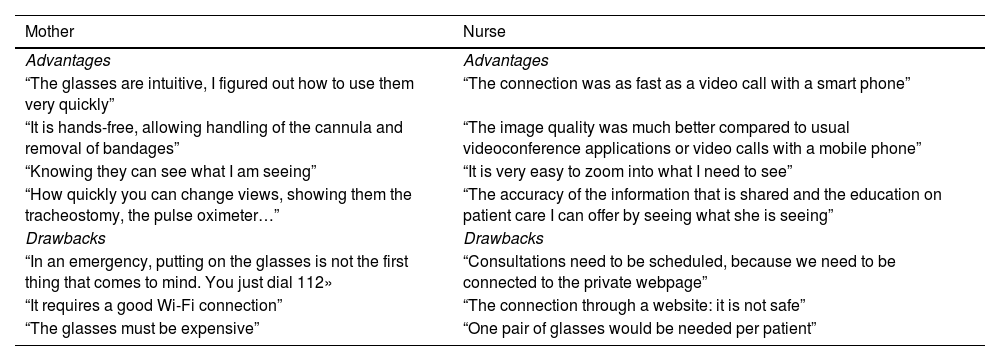Paediatric palliative care (PPC) teams deliver care to children with life-threatening illnesses and their families. Their involvement begins, in many cases, with diagnosis and extends to the most advanced stages of disease through the end of life, continuing with bereavement care for the family. Although many PPC units have been created in Spain, they are still insufficient, and families demand that these services be offered throughout the country and that home care be provided under the best possible conditions.1
In the home setting, parents are the primary providers of care for their children, ranging from basic (grooming, feeding and administration of drugs) to complex (management of tracheostomies and mechanical ventilation systems, etc). At any time, incidents may arise in relation to care delivery, medical devices or the underlying disease (fever, seizures, metabolic decompensation episodes, etc).
In this regard, telecare has brought about substantial changes in the remote care of patients with chronic and complex conditions,2 although it has been based mostly on telephone and videoconference communications. These remote appointments allow immediate access and are highly valued by families,3 although they could improve with the help of new hands-free communication devices and augmented reality functionalities.4,5 For this reason, and in order to assess the potential of this technology in the delivery of PPC, we carried out a pilot study in our Paediatric Chronic Disease and Palliative Care Unit.
We used the Vuzix Blade Upgraded augmented reality smart glass model (USA) with the Vuzix Remote Assist (VRA) application, which can be used to make video calls to any device, in our case, a laptop computer connected to the online application (https://vra.vuzix.com). Once the connection is established, communication is hands-free, so that both the individual wearing the glasses and the provider share the same screen and the provider can, if needed, send images or videos to the glasses that are displayed in the lens of the wearer without blocking their view of their environment (patient, device, etc.) (Fig. 1).
To carry out the test, we obtained the consent from the parents of one of our patients hospitalised at home. We proposed a hypothetical scenario concerning the patient's tracheostomy in which mother would be the only caregiver present, who therefore would need to contact our unit. A member of our care team visited the home, to explain to the mother how to use the glasses (which she was not familiar with) and give her instructions on how to call the nurse at the hospital. The virtual consultation lasted 20min. After the video call, we recorded the opinions of both the mother and the nurse regarding the advantages and disadvantages of this technology (Table 1).
Advantages and drawbacks of using smart glasses for telecare, from the perspective of the patient’ mother and a nurse.
| Mother | Nurse |
|---|---|
| Advantages | Advantages |
| “The glasses are intuitive, I figured out how to use them very quickly” | “The connection was as fast as a video call with a smart phone” |
| “It is hands-free, allowing handling of the cannula and removal of bandages” | “The image quality was much better compared to usual videoconference applications or video calls with a mobile phone” |
| “Knowing they can see what I am seeing” | “It is very easy to zoom into what I need to see” |
| “How quickly you can change views, showing them the tracheostomy, the pulse oximeter…” | “The accuracy of the information that is shared and the education on patient care I can offer by seeing what she is seeing” |
| Drawbacks | Drawbacks |
| “In an emergency, putting on the glasses is not the first thing that comes to mind. You just dial 112» | “Consultations need to be scheduled, because we need to be connected to the private webpage” |
| “It requires a good Wi-Fi connection” | “The connection through a website: it is not safe” |
| “The glasses must be expensive” | “One pair of glasses would be needed per patient” |
We consider that this preliminary experience, conceived as a proof of concept to take further steps in this line of investigation, has been positive, and that further research and resources need to be invested in this approach to remote assistance and care, which has the potential to improve quality of care and family empowerment.
The mother and the nurse agreed on the ease of use of the glasses, the image quality and the importance of being able to ‘share what you see’ and have your hands free to do things with a ‘live’ audiovisual guide (Table 1).
When it comes to the potential drawbacks, the need for a good wireless connection should not be a problem in most households. However, the cost of the glasses (€1500 for the model used in the pilot study) and the user license for the virtual platform (€100 a month) may be a limitation at the present time. However, the rapid pace of technological progress is associated with significant drops in cost, and glasses with similar features are already available on the market for a price similar to that of a mid-range mobile phone.
We believe that effective and affordable technology is currently available and that efforts should be made to apply it to the remote care of children with chronic and complex conditions and their families. If the potential benefits of this technology are confirmed, actions should be taken in parallel to its implementation to regulate and control its widespread use (consent, dissemination of images, data security, etc.).
FundingThis research did not receive any external funding.
Conflicts of interestThe authors have no conflicts of interest to declare.







